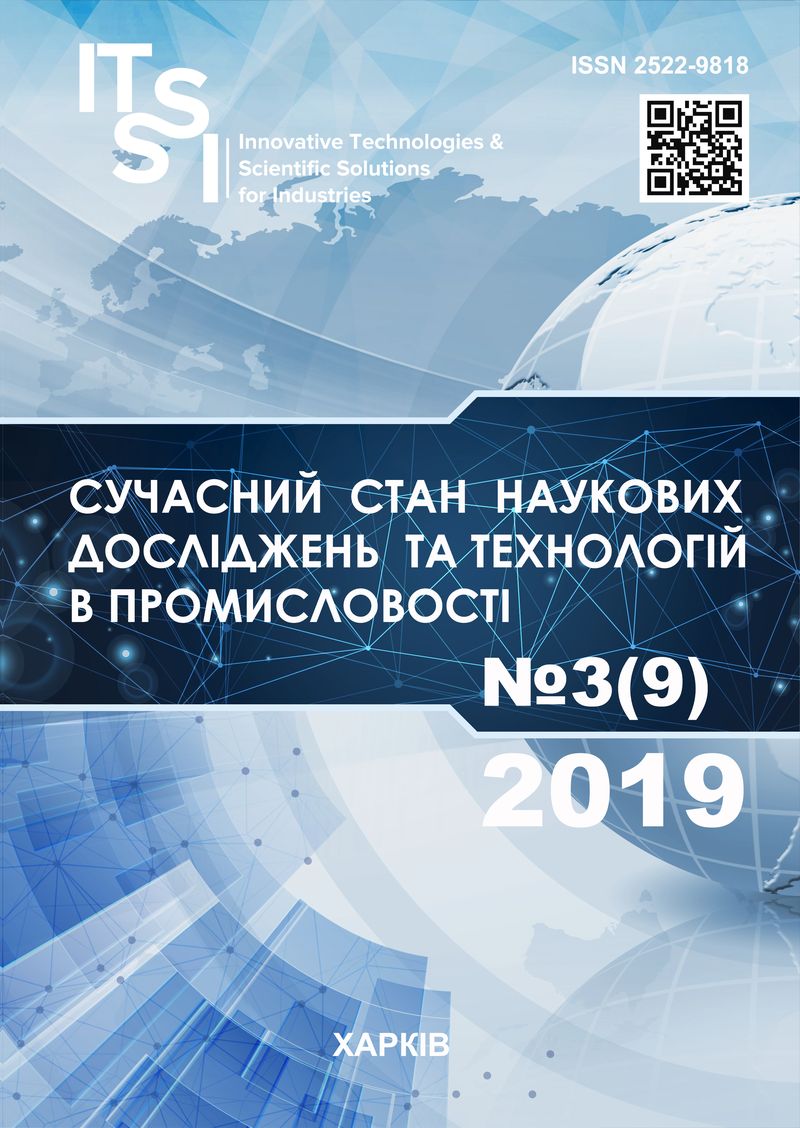МОДЕЛЮВАННЯ ПАРАМЕТРІВ НАВАНТАЖЕННЯ КОМП'ЮТЕРНОЇ МЕРЕЖІ ПРОТЯГОМ ЗАДАНОГО ПЕРІОДУ ЧАСУ
DOI:
https://doi.org/10.30837/2522-9818.2019.9.072Ключові слова:
комп’ютерна мережа, імітаційне моделювання, системна динаміка, модель OSI, трафікАнотація
Предметом дослідження в статті є процеси передачі даних в комп’ютерних мережах з погляду на функціональні та нефункціональні показники якості роботи мережі. Мета роботи – формалізація характеристик комп’ютерної мережі, які враховуються в методі моделювання та демонстрація роботи методу за допомогою тестового прикладу. В статті вирішуються наступні завдання: обґрунтування необхідності застосування методів моделювання під час модернізації комп’ютерних мереж; визначення характеристик комп’ютерної мережі, які мають вплив на процеси передачі даних; формалізація показників, які будуть безпосередньо застосовуватися в процесі моделювання; опис тестового прикладу для роботи моделі; ітеративне імітаційне моделювання роботи мережі. Використовуються такі методи дослідження: основи системного аналізу, моделі функціонування мережі, метод імітаційного моделювання. Отримано наступні результати: комп’ютерна мережа розглянута з боку функціональних та нефункціональних характеристик ефективності, виділені характеристики, які впливають на якість надання послуг, а також такі, що впливають на вартість побудованої мережевої топології. Представлені формули обчислення обсягу інформаційного ресурсу мережі. Обґрунтовано перелік основних характеристик мережі, які мають бути ураховані при моделюванні навантаження мережі. Описаний тестовий стенд для роботи моделі. Розрахований ілюстративний пример використання методу моделювання на основі тестових даних. Висновки: Зроблено висновок, що урахування великої множини показників ефективності мережі перевантажить процес моделювання та прийнято рішення обрати загально-універсальні показники комп’ютерної мережі, які б не залежали від топології її побудови, або типу протоколу, який використовується. Підтверджено можливість створення імітаційної моделі роботи комп’ютерної мережі для її використання при прогнозуванні поведінки мережі під час зміни кількості запитів. Подальший розвиток методу дозволить прогнозувати моменти перевантаження мережі запитами для підвищення ефективності використання комп’ютерної мережі, що модернізується.
Посилання
Reva, A., Davydovskyi, Yu. (2018), "Method of the network topology transformation to quasihomogeneous structure", Radioelectronic and computer systems, No. 2, P. 43–51. DOI: https://doi.org/10.32620/reks.2018.2
Davydovskyi, Yu., Reva, A., Malyeyeva, O. (2018), "Method of modelling the parameters of data communication network for its upgrading", Innovative Technologies and Scientific Solutions for Industries, No. 4 (6), P. 15–22. DOI: https://doi.org/10.30837/2522-9818.2018.6.015
Internet World Stats: Usage and Population Statistics, URL: https://www.internetworldstats.com/stats.htm
Cisco VNI, “Cisco Visual Networking Index: Forecast and Trends, 2017–2022”, URL: https://www.cisco.com/c/en/us/solutions/collateral/service-provider/visual-networking-index-vni/white-paper-c11-741490.html
Zhuang, Y., Cappos, J., Rappaport, T., McGeer, R. Future Internet Bandwidth Trends: An Investigation on Current and Future Disruptive Technologies. Secure Systems Lab, Dept. Comput. Sci. Eng., Polytech. Inst. New York Univ., New York, NY, USA, Tech. Rep. TRCSE-2013-0411/01/2013, URL: https://www.semanticscholar.org/paper/Future-Internet-Bandwidth-Trends%3A-An-Investigation-Zhuang-Rappaport/5b8d6b99770c8e4045b40ed3f3a5aea1ff202fd2
Lakhina, A., Papagiannaki, K., Crovella, M., Diot, C. (2004), "Structural Analysis of Network Traffic Flows", ACM SIGMETRICS Performance Evaluation Review, No. 32 (1), P. 61–72
Nevliudov, I., Tsymbal, O., Bronnikov, A. (2018), "Intelligent means in the system of managing manufacturing agent", Innovative Technologies and Scientific Solutions for Industries, No. 1 (3), P. 33–47. DOI: https://doi.org/10.30837/2522-9818.2018.3.033
Averin, G. V. (2014), Systemodynamics, Donetsk : Donbass, 403 p.
The AnyLogic Company. Discrete Event Simulation, URL: https://www.anylogic.ru/use-of-simulation/discrete-event-simulation/
Kovalenko, A., Kuchuk, H., Ruban, I. (2018), "Using time scales while approximating the length of computer networks", Innovative Technologies and Scientific Solutions for Industries, No. 2 (4), P. 12–18. DOI: https://doi.org/10.30837/2522-9818.2018.4.012
Kosenko, V., Persiyanova, E., Belotskyy, O., Maleyeva, O. (2017), "Methods of managing traffic distribution in information and communication networks of critical infrastructure systems", Innovative Technologies and Scientific Solutions for Industries, No. 2 (2), P. 48–55. DOI: https://doi.org/10.30837/2522-9818.2017.2.048
Wilensky, U., William, R. (2015), An Introduction to Agent-Based Modeling, MIT Press, 504 p.
Malyeyeva, O., Davydovskyi, Y., Kosenko, V. (2019), "Statistical analysis of data on the traffic intensity of Internet networks for the different periods of time", Second International Workshop on Computer Modeling and Intelligent Systems (CMIS-2019), P. 897–910.
Poshtarenko, V. M., Andreev, A. Yu., Amal, M. (2013), "Service quality assurance at critical sections of a multiservice network", Newsletter of the National Technical University, No. 60, P. 94–100.
Mathematical foundations of the theory of telecommunication systems, in general. ed. V. V. Popovsky, Kharkiv : SMIT Company LLC, 2006, 564 p.
Modems and routers for IP-based networks, URL: https://w3.siemens.com/mcms/industrial-communication/en/industrial-remote-communication/remote-networks/Pages/modems-routers-ip-based-networks.aspx
Kozlov, S. V., Ostrikov, Yu. P., Sukhanov, A. L. (2014), "Optimal distribution of information and computing resources based on a two-level criterion", Management of large systems: Sat tr, P. 71–84.
Pyatibratov, A. P., Gudyno, L. P., Kirichenko, A. A. (2016), Computing systems, networks and telecommunications, Moscow : Publishing house: "Prospect", 332 p.
Saleem Bhatti, "Channel capacity", Lecture notes for M.Sc. Data Communication Networks and Distributed Systems D51 -- Basic Communications and Networks. URL: https://web.archive.org/web/20070821212637/http://www.cs.ucl.ac.uk:80/staff/S.Bhatti/D51-notes/node31.html
##submission.downloads##
Як цитувати
Номер
Розділ
Ліцензія
Авторське право (c) 2019 Yurii Davydovskyi, Oleksandr Reva, Olesia Artiukh, Viktor Kosenko

Ця робота ліцензується відповідно до Creative Commons Attribution-NonCommercial-ShareAlike 4.0 International License.
Наше видання використовує положення про авторські права Creative Commons для журналів відкритого доступу.
Автори, які публікуються у цьому журналі, погоджуються з наступними умовами:
Автори залишають за собою право на авторство своєї роботи та передають журналу право першої публікації цієї роботи на умовах ліцензії Creative Commons Attribution-NonCommercial-ShareAlike 4.0 International License (CC BY-NC-SA 4.0), котра дозволяє іншим особам вільно розповсюджувати опубліковану роботу з обов'язковим посиланням на авторів оригінальної роботи та першу публікацію роботи у цьому журналі.
Автори мають право укладати самостійні додаткові угоди щодо не комерційного та не ексклюзивного розповсюдження роботи у тому вигляді, в якому вона була опублікована цим журналом (наприклад, розміщувати роботу в електронному сховищі установи або публікувати у складі монографії), за умови збереження посилання на першу публікацію роботи у цьому журналі.
Політика журналу дозволяє і заохочує розміщення авторами в мережі Інтернет (наприклад, у сховищах установ або на особистих веб-сайтах) рукопису опублікованої роботи, оскільки це сприяє виникненню продуктивної наукової дискусії та позитивно позначається на оперативності та динаміці цитування опублікованої роботи.














